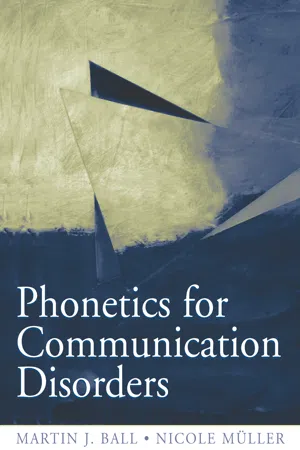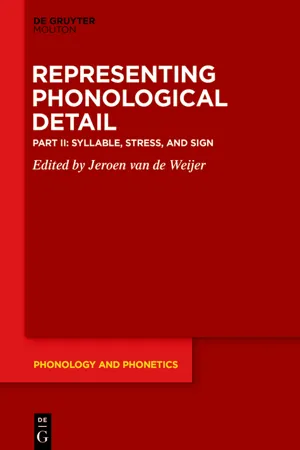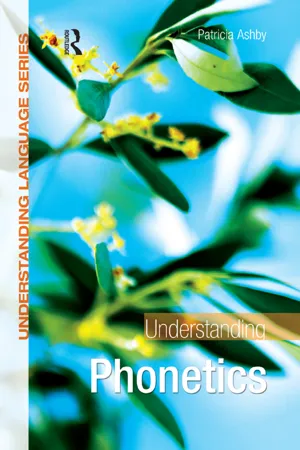Languages & Linguistics
Diphthong
A diphthong is a complex vowel sound that begins with one vowel quality and gradually glides into another within the same syllable. This results in a single, unique sound that is a combination of two vowel qualities. Diphthongs are found in many languages and play a significant role in phonetics and phonology.
Written by Perlego with AI-assistance
4 Key excerpts on "Diphthong"
- eBook - PDF
- Martin J. Ball, Nicole Muller(Authors)
- 2014(Publication Date)
- Psychology Press(Publisher)
Diphthongs, as we noted in chapter 5, are vocalic glides of the tongue, where we note the starting and finishing points and assume a smooth movement between the two. Diphthongs are completed within a single syllable, and so differ from the juxtaposition of two vowels across a syllable boundary; Diphthongs are counted as single vowel phonemes of the language. In this chapter we divide the Diphthongs into those with a mid stmting position, those with a low starting position, and the one Diphthong that crosses from back to front across the vowel area. We also include the centering Diphthongs that are found in nonrhotic accents such as RP. As in chapter 11, acoustic data on vowel formants is given. Some of this is based on work by Peters on and Barney (1952) and Hillenbrand et al. (1995); and for those vowels not dealt with by these authors we provide data from Cruttenden (2001). In each case, the dark bands on the spectrogram and the peaks on the spectrum clearly show the formant structure of the vowel. For all the vowel variants described in this chapter, the vocal folds vibrate throughout the production of the vowel, producing voiced phonation; the soft palate is raised so that it blocks off the nasal cavity, resulting in purely oral airflow; and the tongue adopts a convex shape, except for the rhotic vowels, which may have a partly concave shape. Except in the case of lua/, all the Diphthongs we describe can occur word-initially, before and after consonants, and word-finally in open syllables; and they all have a tense tongue during their production, and so belong to the group of long vowels. THE NONRHOTIC CENTRAL VOWELS These vowels are both unrounded. Some authorities consider that they are both lax, whereas others note that /AI is tenser than la/. Tile Low Nonrilotic Central Vowel IAI This vowel is usually described as being a half-low unrounded central vowel. lA! can occur word-initially, before and after consonants, but not word-finally in open syllables. - eBook - ePub
- Jeroen van de Weijer(Author)
- 2023(Publication Date)
- De Gruyter Mouton(Publisher)
Diphthong was originally used to describe a sequence of two vowel letters in alphabetic writing. Since the term came to be applied to the description of vowel sounds, it has often been used to refer to any sequence of vocalic segments written as two phoneme characters. From a phonological viewpoint, this usage is at best vague and at worst downright misleading. It can obscure the different ways in which vocalic sequences are syllabified in different languages. For this reason, it is useful to draw a distinction between what can be called true and fake Diphthongs.IPA-style phonetic transcriptions are of little help in establishing the syllabification of vocalic sequences. First, being fundamentally alphabetic, they typically do not represent syllable structure. Second, conventions vary with respect to whether vocalic sequences should be transcribed with vowel or glide characters, e.g. [au] versus [aw]. As shown in (1a), a true Diphthong can be defined as a vocalic sequence (ωω) that is contained within the same syllable nucleus (N). A fake Diphthong can take one of two forms. One, shown in (1b), is where the two vocalic units belong to separate nuclei and thus to separate syllables. The other, shown in (1c), is where one unit belongs to a nucleus and the other to a neighbouring non-nuclear position; whether the latter is a coda (Co) or an onset (O) is not immediately relevant here.(1)(a)True(b)Fake I(c)Fake IIThere are various ways of telling when we are dealing with a true Diphthong. For one thing, it exhibits prosodic integrity: it counts as a single landing site for stress or tone, and in languages with quantity-sensitive stress it defines a single domain of weight. For another, since a true Diphthong forms a single nucleus, its phonological distribution parallels that of monophthongs. For example, if a language allows word-final consonants, they can be preceded by any vowel, be it a monophthong or a Diphthong. Both of these criteria are met by up-gliding Diphthongs in English, including the /ow/ of the GOAT lexical set, the vowel we are interested in here. /ow/ belongs to a single syllable unit for the location of stress and the calculation of weight. It can also appear before a word final consonant (e.g. rope, loaf, loan), just like monophthongs can (e.g. step, deaf, ten - eBook - ePub
- Patricia Ashby(Author)
- 2013(Publication Date)
- Routledge(Publisher)
MRP typically pronounces 1, 5, 7 and 8 with Diphthongs. In spite of their spelling, the rest are monophthongs in this accent. In many other accents, however, including a number of northern accents of English (from what Wells 1982 identifies as the ‘middle north’ group) and most Scottish English accents, only the vowels in 7 and 8 are Diphthongs. Some speakers, however, will also have a Diphthong in items 2 and 4 as well (speakers with Australian or broad London (Cockney) accents, for example, or with an accent from parts of the midlands or the north-west of England (such as Birmingham and Liverpool).Ex 7.5.a) All Diphthongs in this group glide towards schwi: 1. [ ], 2. [ ], 3. [ɔ ]b) All Diphthongs in this group glide towards schwu: 1. [ ], 2. [ ]Note here the different phonetic qualities from which the Diphthongs /aɪ/ and /aʊ/ begin. This is only reflected in the narrow phonetic transcription and does not show up in the simplified, phonemic symbols.Ex 7.6.Usual answers to this question include the following perceptions: • With either one or two syllables: 1, 3, 4, 5, 6, 8, 9, 10.• Within this group, some people will feel that the monomorphemic words have just one syllable, hire, for example, or wire, quire/choir and flour while the bimorphemic higher, player and mower (high + er, etc.) have two.• This same argument is sometimes made for the words in flower growers. Some people feel strongly that each word has just one syllable or that each word has two while others feel that monomorphemic flower has one but bimorphemic growers has two.• Curious is even more curious… people will argue for two, three or even four syllables here! People who feel there are four seem to perceive the [ʊə] Diphthong as a vowel sequence of [u ] + [ə], making it homophonous with a queue-er (someone who queues).Ex 7.7.Using slightly less narrow representations of the qualities (some of the detailed diacritics have been omitted where there is no possibility of confusion):(1) [a ə] first becomes [a ] and then [a - eBook - ePub
From Sounds to Structures
Beyond the Veil of Maya
- Roberto Petrosino, Pietro Cerrone, Harry van der Hulst(Authors)
- 2018(Publication Date)
- De Gruyter Mouton(Publisher)
6 I will present some of the previous proposals about the syllabic role of Italian on-glides, as well as my own hypothesis. While previous analyses have argued that Italian glides are basically consonantal (on-glides belonging to the onset, and off-glides belonging to the coda), I will try to show that they are essentially vocalic in nature. On-glides are always syllabified within the nucleus, and form a single complex vocalic segment with the following root node (with the exception of the glide [w] after velar stops, which forms a complex consonantal segment with the latter). I will also argue that off-glides too are part of the nucleus, but as an independent segment of the Diphthong they belong to. In order to prove these claims, I will present evidence from assimilatory processes, article allomorph selection, phonotactic distribution, and vowel duration.2 Diphthongs and hiatuses
Before discussing glides in detail it may be useful to briefly examine their complex relationship with hiatuses. Glides typically occur next to a vowel, the two forming a Diphthong – traditionally, Diphthongs are defined as combinations of a vowel and a preceding or following glide (called ‘on-glide’ and ‘off-glide’ respectively) within the same syllable.1 When dealing with vocoid sequences, the question often arises whether they are Diphthongs or hiatuses, the latter being defined as sequences of two syllabic nuclei. In fact, as simple and straightforward as they may be in theory, these definitions sometimes run into practical difficulties. Practically distinguishing Italian hiatuses from Diphthongs may prove to be a tall order (see Marotta 1987 for a detailed discussion), mainly because the phonetic difference between the two categories is basically a continuum (Salza, Marotta, and Ricca 1987 ). Furthermore, underlying hiatuses may be realized as Diphthongs (this possibility also occasionally extends to hiatuses with initial mid vowels, as (1b) shows).(1) a. b [i]ologia ‘biology’ in slow speech → b [j]ologia in fast speech b. parto cesar [e]o ‘Cesarean section’ → parto cesar [j]o (non-standard) It has to be added, however, that in Italian the change is unidirectional; hiatuses may optionally become Diphthongs, but underlying Diphthongs never become hiatuses. A realization as in (2) would only be possible at an unnatural, artificially slow speech rate.(2) a. p [j]ede ‘foot’ → ?* p [i]ede Vowel/glide alternations seem to be affected by various factors (Marotta 1987 : 871–877). One of them is lexical stress, as hiatuses tend to be preserved if one their vowels is stressed (a typologically common pattern – see e.g. Casali 1997 ); for instance, b [j]ologìa is more likely than b [j]òlogo ‘biologist’, ubr [i]àco ‘drunkard’ is more likely than ubr [i]acàrsi ‘to get drunk’. Another factor is sociolinguistic variation; in fast, allegro speech and informal contexts the Diphthongization of hiatuses is more common. Finally, morphological boundaries also play a role, as the Diphthongization of a hiatus is blocked (or at least is much less likely, even in fast speech) if a morphological boundary occurs between the two vowels: appendiabiti / apˈpɛndi#ˈabiti/ [apˈpɛndiˈaːbiti] ‘coat hanger’, riarmare /ri+arˈmare/ [riarˈmaːre] ‘rearm’, antiacari /ˈanti+ˈakari/ [ˈantiˈaːkari] ‘antiacarian’. There is also some geographical variation; for example, the standard Italian pronunciation of viaggio
Index pages curate the most relevant extracts from our library of academic textbooks. They’ve been created using an in-house natural language model (NLM), each adding context and meaning to key research topics.



